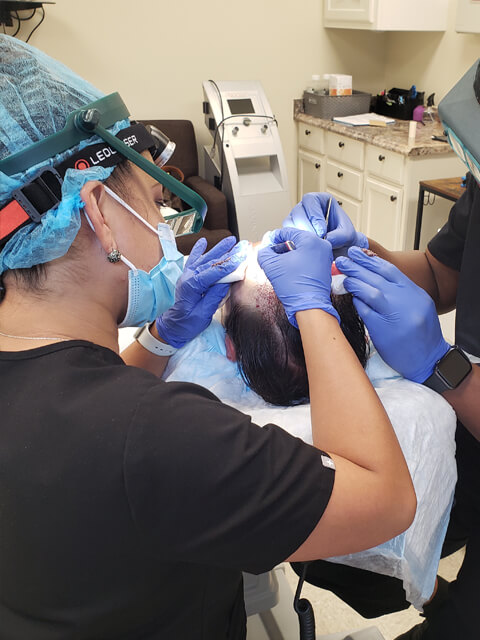If you’re balding or suffering from thinning hair, a hair transplant is by far the best step you can take to reverse your loss and restore a fuller head of hair. But is there something you can do to make extra sure all that transplanted hair grows nicely after your procedure?
There is! HypoThermosol® is a graft storage solution that can be used during transplants to promote follicle growth and reduce swelling. Its use in hair restoration is relatively new, but at Nashville Hair Doctor we now offer Hypothermosol with all hair transplants of 2,500 grafts and over. If you are interested in a smaller procedure with HypoThermosol, please ask our consultant for pricing when you place your quote request.
Benefits of HypoThermosol After a Hair Transplant
Why HypoThermosol?
To understand the power of HypoThermosol, let’s review briefly how hair transplants work. During a hair transplant procedure such as NeoGraft, the doctor or technician removes a “follicular unit” containing 1-4 hair follicles from an area of the scalp that has plenty of healthy hair (aka the donor area). After the hair grafts are harvested, they are inserted into the scalp in areas affected by hair loss (the recipient areas). The hair continues to grow in these new areas to restore thickness.
As you can imagine, the success of a hair transplant vastly depends on how well the implanted grafts “take” to their new location. And there are several steps a surgeon can take to ensure these grafts get the best possible start in their new life. Hydration, temperature, time away from the scalp, and expert handling of the grafts during transfer all play a role. Any clinic doing professional hair restoration on a routine basis will have a process that takes great care that all these variables are just right.
But now there is a new factor hair surgeons are realizing can further improve the outcome of a transplant. Storing the hair grafts in a HypoThermosol solution during transition has been found to enhance the preservation of hair grafts and to mitigate damage and stress.

How HypoThermosol works
In the past, hair clinics have relied on a sterile saline solution for the preservation of hair follicles. To be clear, this saline solution provides great benefits to follicle storage during a hair transplant by preventing dehydration and protecting the follicles from contamination.
Using HypoThermosol instead of saline is like adding a fertilizer to a plant. Imagine you are planting a shrub. You would try to move as quickly as possible from taking the plant out of its pot to placing it into the soil so it can take root. On a hot day, you would want to keep the root ball well watered while the plant is out of the pot but not in the soil yet. You would want to keep it away from the hot sun and you wouldn’t want to let any harmful chemicals enter the soil. If you took all those precautions and watered the plant well, you would be pretty sure to get a thriving plant.
But you might be able to get the plant to grow even faster and perhaps bloom earlier by adding fertilizer to the soil.
Think of HypoThermosol as a kind of fertilizer for hair. It provides moisture to the follicular units while they await transplantation just like a saline solution does, but it also adds vital nutrients that help promote growth. The follicles are without blood supply and oxygen while they await transplantation, and HypoThermosol has been found to be able to better tide them over until they are able to generate their own again. In a recent study, hair grafts were stored for 5 days (the amount of time it typically takes for transplanted hair follicles to absorb nutrients from the body again) in two different chilled solutions – one group in saline, and the other in HypoThermosol. Then they were implanted in the patient. After 18 months, the hair grafts stored in HypoThermosol showed a distinctly higher survival rate.
As an added benefit, the use of HypoThermosol has also been found to reduce post-surgery swelling. For all these reasons, HypoThermosol is quickly becoming a new industry standard for hair transplants. It is in compliance with FDA cGMP guidelines.
Giving Your Hair Transplant the Best Chances
A hair transplant is not an inexpensive procedure. And you essentially have a fixed amount of good genetic hair that can be used as a harvest site. Doing all that you can to give this valuable and limited resource the best conditions to thrive is common sense. It’s near-impossible for every single graft to take to its new location. Some will not make it, and that’s completely normal. But the higher the percentage of surviving grafts, the more effective your hair transplant will be (and the more donor hair you’ll have left, should you consider a future procedure down the road).
In the words of Nashville Hair Doctor patient David Bernard, the key to a successful hair transplant is to “baby your hair,” especially the first week after your surgery. Your provider will give you instructions on how to wash your hair, when it’s safe to wear a hat again, and how to sleep. See David’s results to learn why he is so happy about his transplant just 6 months afterwards.


Make sure you ask your provider if they are using HypoThermosol to help “baby your hair!” If you want to find out if you are a good candidate for a hair transplant, upload your picture to receive a FREE quote for a NeoGraft hair transplant from Nashville Hair Doctor. We also serve patients in Memphis, TN, and Louisville, KY and offer a travel discount to all other out-of-town patients.
References:
U.S. National Library of Medicine, Hair restoration surgery: challenges and solutions

